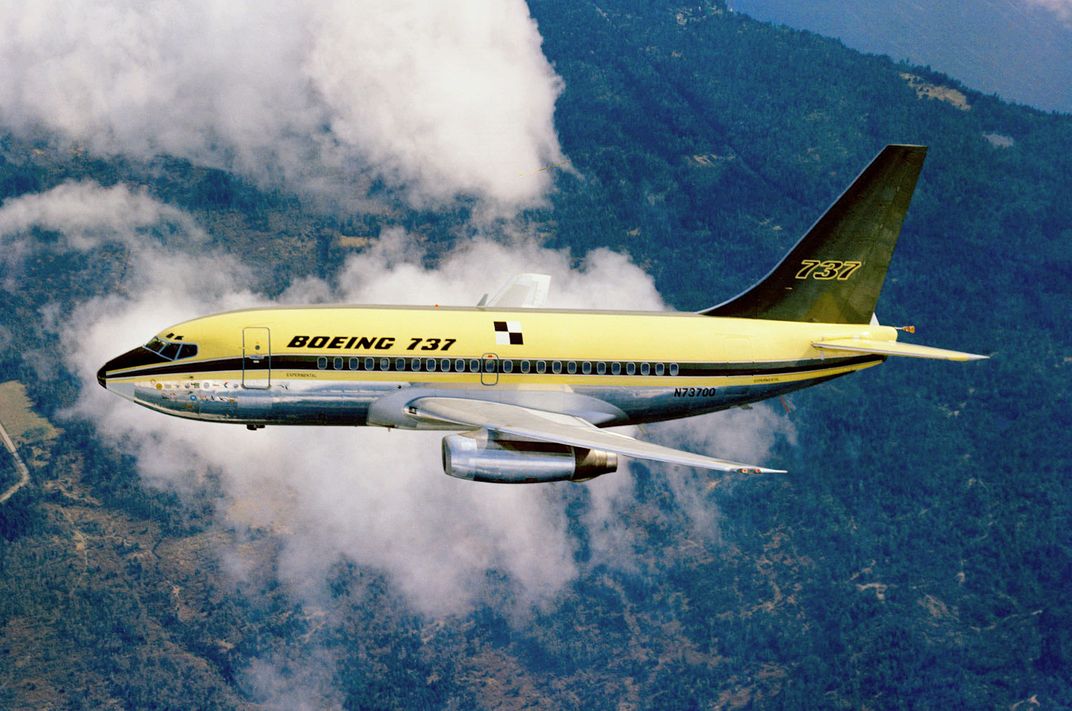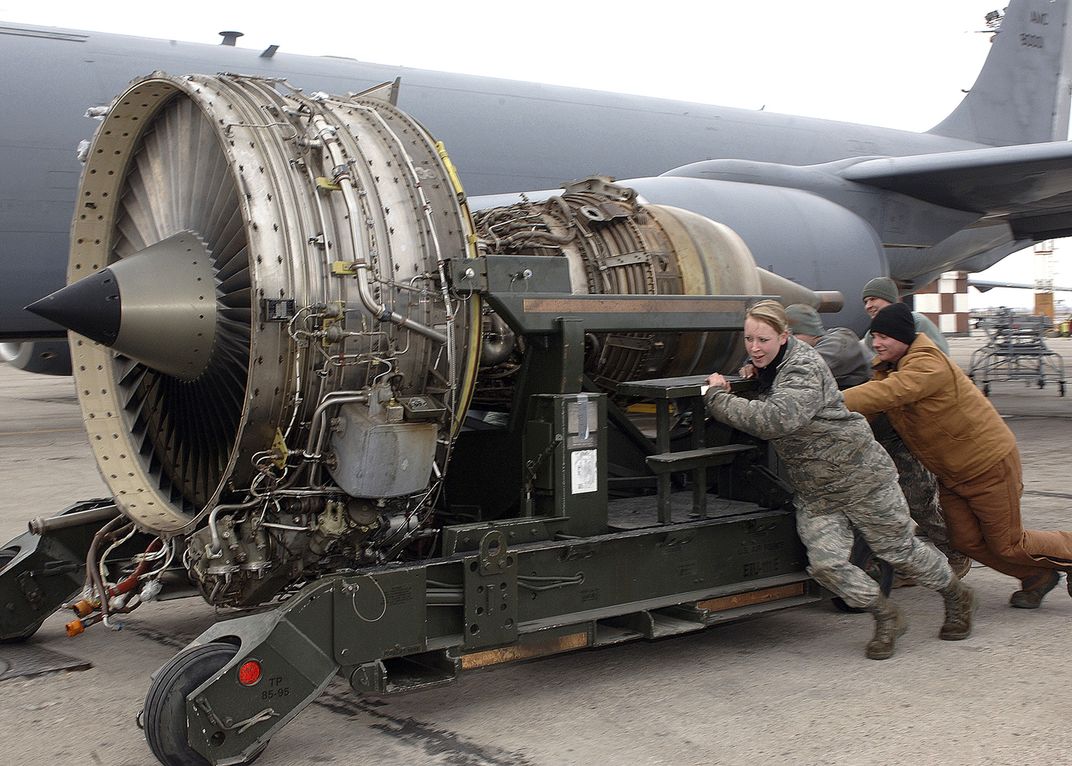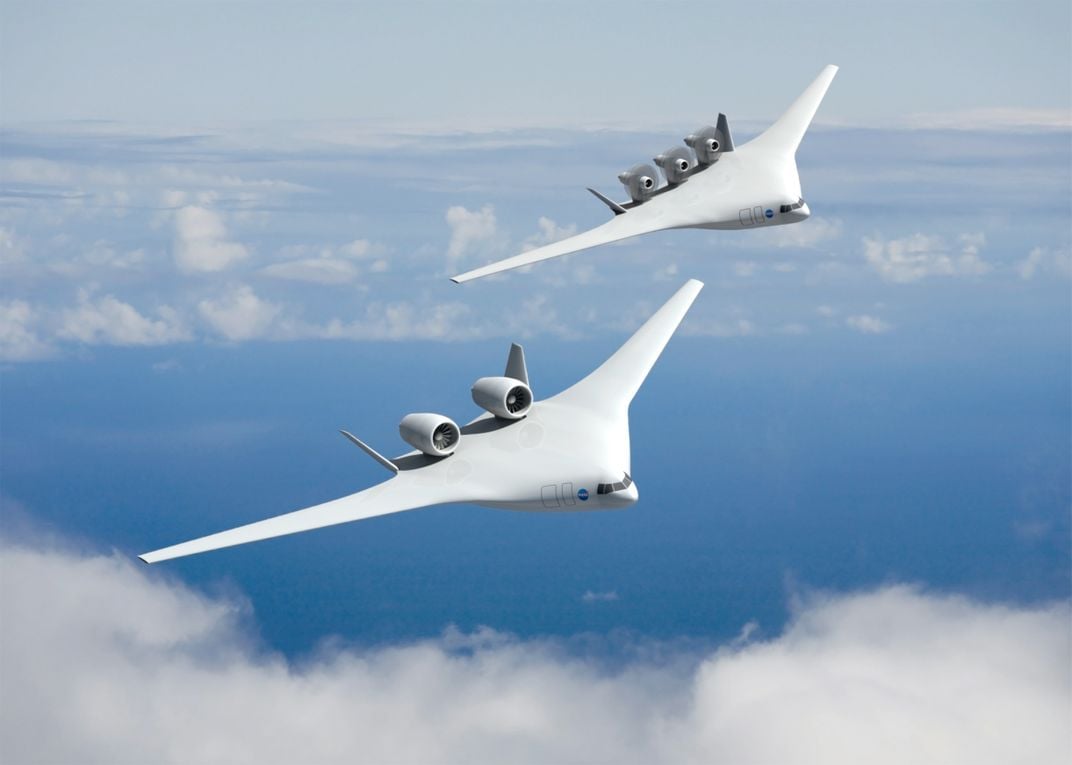Is [Your Invention Here] The Future of Aviation?
Probably not. In the airline business, innovation takes a back seat to fuel efficiency.
/https://tf-cmsv2-smithsonianmag-media.s3.amazonaws.com/filer/11/b8/11b8838a-7f42-4665-a932-fbee1fc1d66e/concept_plane_new_york.jpg)
The first Boeing 737 was rolled out in 1965, and after a few major modifications, it became the popular 737-200. Its replacement was another variant, now called “classic” 737s, the first of which flew in 1984. The replacement for those rolled out in 1996, and was dubbed 737 Next Generation. Now the first of those aircraft are reaching the end of their service lives, and Boeing needs a replacement. The company’s solution, scheduled to enter service in 2017, is another new 737 model, the “MAX.”
Depending on how they’re used, commercial airplanes fly up to 25 years on the front line, and even longer if they’re re-sold to non-U.S. carriers. Assuming a normal production line and operating life, the as-yet-unbuilt 737 MAX models will continue to roll off production lines until (or maybe even after) its replacement enters service, so 737s will still be carrying passengers until maybe 2045. That’s eighty years of 737s.
Recently, Boeing informally announced an intended replacement for the 737 MAX, starting around 2030. Not much is publicly known (and probably not yet privately decided) about the “New Small Airplane,” but Boeing executives said it will be a conventional tube-and-wing design, with two underslung engines and lots of metal—in other words, it will look a lot like a 737.

We’ve all seen the stories: “Future airliners will be _____!” You can fill in the blank with anything from transparent to made of carbon nanotubes to powered by lasers. The predictions are largely based on academic studies or patent filings by major manufacturers. Many such claims are actually technically feasible today, albeit with plenty of applied engineering still to be done. Despite that, it seems every new airplane looks a lot like what it replaces.
“Boy, looking back at the past half-century doesn’t give a lot to inspire, does it?” says Richard Aboulafia, a prominent airline analyst. “The one thing I can tell you is that every decade, turbines get better by double digit [fuel burn] percentage. Maybe that kind of tends to forestall improvements elsewhere.”
Airlines are notoriously low-margin businesses. (Warren Buffet once suggested that aviation’s net profit, from the Wright Brothers onward, was zero.) And because their largest cost is fuel, they have a huge incentive to minimize fuel burn. The fuel burn rate is influenced by many things, including the shape and span of the wings, drag created by the fuselage and overall aircraft weight. But the most important factor by far is the engines.
“In many ways it’s easily forgotten, because these [airplane manufacturers] are different companies, but you don’t design an engine for a plane, you design an airplane around an engine. You want a fascinating case study, it’s the horrible experience of Bombardier’s C-Series.” says Aboulafia. “What happened was, of course Airbus and Boeing wouldn’t re-engine their current jetliners, because why should they? People think of the C-Series as a Bombardier jet. It really isn’t, it’s a type of Pratt & Whitney jet. Pratt [an engine manufacturer] helped make [C-Series] happen, and said, ‘So Airbus and Boeing, would you like to start losing business to Bombardier?’ At which point Airbus re-engined, Boeing re-engined, and the two of them have just been crushing the C-Series.”
New engines are the real drivers of commercial aviation design, and every new generation of jet engines that emerges burns about 10-12% less than its immediate predecessor. The trend in engines has been towards increasing bypass ratios, hotter operating temperatures and more efficient gears, all of which lead to less fuel per pound of thrust pushed out the back.
The rest of the airplane only makes a small difference in comparison. As Aboulafia points out, even though Boeing’s heralded 787 uses much less fuel than the 767 it replaces, the company could have simply re-engined the 767 to reach almost the same performance at a fraction of the cost. That is precisely why Airbus, replacing its long-range A330, is doing so by simply putting a new engine on it. The A330neo, as it’s known, will not save quite as much fuel as a 787, but Airbus is betting that its lower acquisition and infrastructure costs will entice the airlines anyway.
Re-engining is harder than it sounds. Gone are the days when airplanes were drastically overbuilt to reduce uncertainty—modern computer-aided design allows for designing exactly to the requirements and not one iota more. That means that even though some older aircraft—most famously the Boeing 707 and McDonnell Douglas DC-8—can simply swap old engines for new ones, it’s more complicated for newer aircraft.

But surely, due to competitive pressure and new environmental regulations, things will change?
Not for a long time, and stop calling me Shirley.
Given the airlines’ obsession with reducing their largest cost, you might think manufacturers would jump enthusiastically on anything that could really save fuel. Certainly the modern era has seen leaps in technology, including aerodynamics and materials. But the airline industry, as a commercial engine designer once told me, is a bunch of very conservative people congratulating one another on their daring.
For decades aerodynamicists have known that the ancient tube-and-wing-with-underslung-engines configuration is inefficient. The wing generates lift, which is good, but the fuselage, tail and other parts of the aircraft only create drag. We know how to change that. Experimental lifting bodies have been flown for decades, as have flying wings, blended-wing bodies and other innovative designs. Mounting the engines above the wings or fuselage greatly reduces noise. Aircraft without tails can save large amounts of weight. Canards can provide greater stability. Open-rotor engines provide infinite bypass ratios. As for environmental conerns, power sources like liquid natural gas, electric batteries or hydrogen can effectively reduce carbon emissions, and all of these technologies are flying experimentally. (One B-36 bomber even flew with a nuclear reactor, which was never switched on, but at least the engineers were thinking about it.)
Not all these innovations are ready for prime time, but they’ve all flown in some form. Still, even though the airline industry is clearly aware of them (Boeing has gone so far as to fly a scale model blended wing-body, and Airbus has its very own electric aircraft), nobody is eager to adopt them for the commercial fleet. Aviation reporters’ shelves are filled with models and artists’ conceptions of strange-looking designs, with titles like ‘The Airplane of the Future!’ According to the accompanying press releases, that future is usually about 30 years away. But experience tells us that in 30 years, everything will be pretty much the same.

One tantalizing if distant prospect is disruptive innovation from outside the industry. During a recent talk at MIT, entrepreneur Elon Musk mentioned offhand that he’d done some back-of-the-napkin calculations for a “notional supersonic, electric, tailless VTOL aircraft” and found it both technically and commercially feasible. Right now it’s little more than a paper airplane, but given Musk’s astounding success with SpaceX and Tesla, any watchers from Boeing or Airbus must have shuddered at his words.
So why do Boeing and Airbus keep ceremoniously unveiling future technologies they have little intent to use?
“Never known what to make of that,” says Aboulafia. “Part of it is just that protecting intellectual property isn’t all that expensive, so why not, right? And to a certain extent it could be that you as an employee or a design department or company are judged by the amount of IP you create. Part of it might be, ‘Hey, [it has] a one percent chance of happening, but what does it really cost us to file this patent?’ There are a lot of really loopy ideas that have been protected.”
So things are likely to continue as they have for decades. Somewhere even now, an innovative designer is concocting something fascinating, maybe even on Boeing’s or Airbus’ dime. A slew of articles and internet posts will greet their invention as the Airplane of the Future. Meanwhile, at the nearest airport, your 737 flight is boarding.